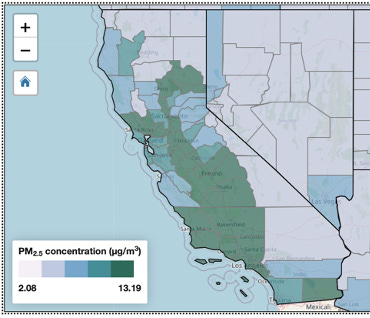Balancing Fire and Air, Part One: California's Prescribed Burn Challenge
As catastrophic wildfires increasingly threaten California, how can the state significantly expand its use of prescribed burns – a key mitigation strategy – while also meeting stricter federal demands
With land management agencies such as the US Forest Service reporting record levels of beneficial fire in 2024 and such projects being credited in saving communities like Angelus Oaks from fast-moving wildfires, last year was a particularly important one for prescribed fire in California. However, a significant development occurred in Washington, DC that could impact these efforts: the US Environmental Protection Agency’s (EPA) revision of the annual PM2.5 standard for the National Ambient Air Quality Standards (NAAQS),1 finalized in February 2024. The finalization of this decision was a consequential victory for environmental justice advocates and an invaluable step towards protecting public health across the country.
Its consequences for the regulation of prescribed fire in California, however, are still not entirely clear, with apparent tension between these two goals:
Scaling up beneficial fire nearly eightfold to hit California’s target of 1.5 million acres annually by 2045–part of the state’s ambitious fuels reduction and fire resilience program.
Reducing the amount of ambient PM2.5 pollution to protect public health and comply with the EPA’s new NAAQS rule.
Multifaceted solutions that engage a wide range of stakeholders are therefore needed to prepare for the smoke impacts of prescribed fire at both the community and regulatory levels and consequently prepare California to achieve these goals simultaneously.
What Our Analysis Shows: How Air Districts will be Impacted
In 2023, a team of students and researchers in Stanford University’s Climate and Energy Policy Program’s (CEPP) Smoke and Wildfire Policy Lab submitted a public comment to the EPA warning that a reduced NAAQS standard for PM2.5 would create serious additional barriers to prescribed fire implementation across the American West (see Figure 1). That consequence would be particularly burdensome in jurisdictions that were already struggling to achieve compliance.
Our preliminary determinations of NAAQS PM2.5 compliance indicate serious challenges already:
Districts essential to achieving the state’s prescribed fire goals are not meeting these new standards already [e.g., Bay Area Air Quality Management District (AQMD) and the San Joaquin Valley Air Pollution Control District (APCD)].
Prescribed fire practitioners express concern that air districts that are borderline in attainment2 may become more hesitant about smoke impacts due to the significant increase in smoke emissions projected as prescribed fire becomes more widespread.

Building Cooperation to Achieve California’s Prescribed Fire and Air Quality Goals
Though challenging, achieving both California's prescribed fire goals and meeting air quality standards is possible. Importantly, a multifaceted approach is needed that incorporates insights from air regulators, prescribed fire practitioners, public health officials, academic researchers, experts on prescribed fire and other controlled burns, and the affected community members themselves. Stanford CEPP was recently funded by the Stanford Accelerator to convene stakeholders to develop policy solutions in this space. By increasing cooperation between stakeholders, building incentives to collect better data about smoke from prescribed fire, and expanding resources to prepare the public for smoke of all kinds, California can facilitate the growth of prescribed fire across the state without compromising adherence to federal air quality standards or public health.
In the next section of this blog series, we describe the policy brief that the CEPP team submitted to the Wildfire & Forest Resilience Task Force in response to the Governor’s State of Emergency proclamation–offering data-driven recommendations to address the tension between beneficial fire and air quality goals while expediting critical wildfire prevention projects across California.
Jessica Yu is a Research Scientist studying the intersection of human and environmental health at the Climate and Energy Policy Program. With a focus on interdisciplinary solutions, her research addresses the public health impacts of wildfire and prescribed fire smoke.
Samuel Hudgens is a Wildfire Legal Fellow at the Climate and Energy Policy Program. His research focuses on the legal framework that governs the use of prescribed fire and the interaction between wildfire and the regulation of insurance.
Under 42 U.S.C. § 7409, the Clean Air Act directs the US EPA to set uniform levels of concentrations of various pollutants in the form of the NAAQS.
Under 42 U.S.C. § 7407, the Clean Air Act requires states to report pollutant levels to the EPA. The EPA then measures these levels against the NAAQS and assigns areas with pollutant levels below the NAAQS standards for that particular pollutant with an “attainment” designation and assigns areas that have exceeded the NAAQS standards for that particular pollution with a “nonattainment” designation.






